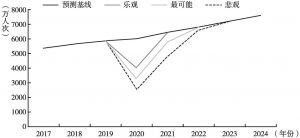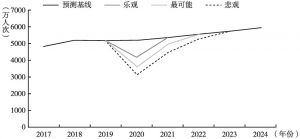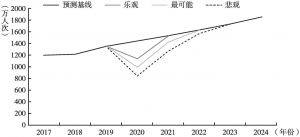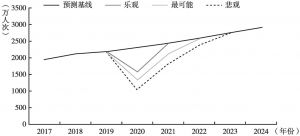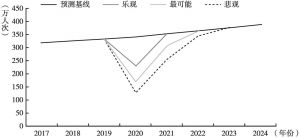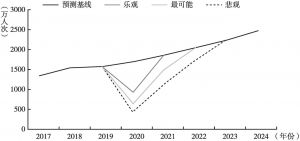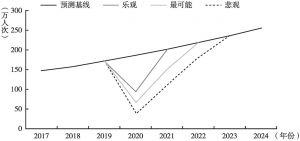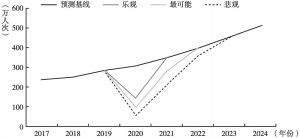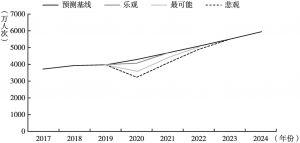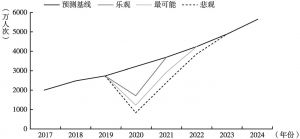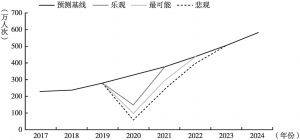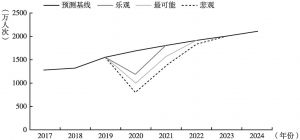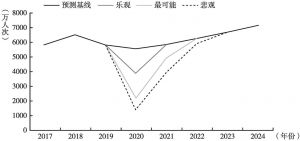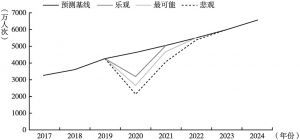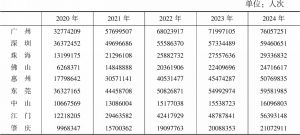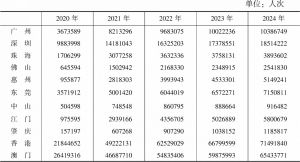摘要
本文利用计量经济方法为粤港澳大湾区11个城市的国内旅游需求和入境旅游需求建立长期增长预测模型,并对COVID-19疫情对旅游需求可能造成的影响进行情景分析。预测和评估结果显示,2020年大湾区各市的旅游需求预期将由于疫情的冲击而大幅下跌,但有望在2021年出现显著回升;入境旅游需求的降幅普遍大于国内旅游需求。对疫情影响程度和旅游需求恢复走势的评估可为大湾区旅游业应对疫情措施的出台和促进旅游产业恢复等政策的制定提供理论和实证参照。
- 广东省统计局,2019,《广东统计年鉴》,广东统计信息网,http://stats.gd.gov.cn/gdtjnj。
- Athanasopoulos,G.,and R. J. Hyndman. 2008. “Modelling and Forecasting Australian Domestic Tourism.” Tourism Management 29:19-31.
- Cooper,M. 2005. “Japanese Tourism and the SARS Epidemic of2003.” Journal of Travel & Tourism Marketing 19:117-131.
- Eugenio-Martin,J.L.,M. T. Sinclair,and I. Yeoman. 2005. “Quantifying the Effects of Tourism Crises:An Application to Scotland.” Journal of Travel & Tourism Marketing 19:21-34.
- Goh,C.,and R. Law. 2002. “Modeling and Forecasting Tourism Demand for Arrivals with Stochastic Nonstationary Seasonality and Intervention.” Tourism Management 23:499-510.
- Goodrich,J. N. 2002. “September 11,2001 Attack on America:A Record of the Immediate Impacts and Reactions in the USA Travel and Tourism Industry.” Tourism Management 23:573-580.
- Hendry,D. F. 1995. Dynamic Econometrics (Oxford:University Press).
- Huang,J.-H.,and J. C. H. Min. 2002. “Earthquake Devastation and Recovery in Tourism:The Taiwan Case.” Tourism Management 23:145-154.
- Keogh-Brown,M. R.,and R. D. Smith. 2008. “The Economic Impact of SARS:How Does the Reality Match the Predictions?” Health Policy 88:110-120.
- Kuo,H.-I.,C.-C. Chen,W.-C. Tseng,L.-F. Ju,and B.-W. Huang. 2008. “Assessing Impacts of SARS and Avian Flu on International Tourism Demand to Asia.” Tourism Management 29:917-928.
- Lee,C.-K.,T. Var,and T. W. Blaine. 1996. “Determinants of Inbound Tourist Expenditures.” Annals of Tourism Research 23:527-542.
- Lim,C. 2004. “The Major Determinants of Korean Outbound Travel to Australia.” Mathematics and Computers in Simulation 64:477-485.
- Lin,V. S.,A. Liu,and H. Song. 2015. “Modeling and Forecasting Chinese Outbound Tourism:An Econometric Approach.” Journal of Travel and Tourism Marketing 32:34-49.
- Min,J. C. H. 2005. “The Effect of the SARS Illness on Tourism in Taiwan:An Empirical Study.” International Journal of Management 22:497-506,508.
- Narayan,P. K. 2004. “Fiji’s Tourism Demand:The ARDL Approach to Cointegration.” Tourism Economics 10:193-206.
- Page,S.,H. Song,and D. C. Wu. 2012. “Assessing the Impacts of the Global Economic Crisis and Swine Flu on Inbound Tourism Demand in the United Kingdom.” Journal of Travel Research 51:142-153.
- Pesaran,M. H.,Y. Shin,and R. J. Smith. 2001. “Bounds Testing Approaches to the Analysis of Level Relationships.” Journal of Applied Econometrics 16:289-326.
- Pine,R.,and B. McKercher. 2004. “The Impact of SARS on Hong Kong’s Tourism Industry.” International Journal of Contemporary Hospitality Management 16:139-143.
- Pizam,A.,and A. Fleischer. 2002. “Severity Versus Frequency of Acts of Terrorism:Which Has a Larger Impact on Tourism Demand?” Journal of Travel Research 40:337-339.
- Prideaux,B.,and S. F. Witt,2000. “The Impact of the Asian Financial Crisis on Australian Tourism.” Asia Pacific Journal of Tourism Research 5:1-7.
- Prideaux,B.,and S. M. Kim. 1999. “Bilateral Tourism Imbalance-Is there a Cause for Concern:The Case of Australia and Korea.” Tourism Management 20:523-531.
- Rassy,D.,and R. D. Smith. 2013. “The Economic Impact of H1N1 on Mexico’s Tourist and Pork Sectors.” Health Economics 22:824-834.
- Ryan,C. 1993. “Crime,Violence,Terrorism and Tourism:An Accidental or Intrinsic Relationship?” Tourism Management 14:173-183.
- Song,H.,and B. Fei. 2007. “Modelling and Forecasting International Tourist Arrivals to Mainland China.” Journal of China Tourism Research 3:20-40.
- Song,H.,and G. Li. 2008. “Tourism Demand Modelling and Forecasting:A Review of Recent Research.” Tourism Management 29:203-220.
- Song,H.,and S. F. Witt. 2003. “Tourism Forecasting:The General-to-Specific Approach.” Journal of Travel Research 42:65-74.
- Song,H.,and S. F. Witt. 2006. “Forecasting International Tourist Flows to Macau.” Tourism Management 27:214-224.
- Song,H.,and S. Lin. 2010. “Impacts of the Financial and Economic Crisis on Tourism in Asia.” Journal of Travel Research 49:16-30.
- Song,H.,K. K.F. Wong,and K. K.S. Chon. 2003. “Modelling and Forecasting the Demand for Hong Kong Tourism.” International Journal of Hospitality Management 22:435-451.
- Song,H.,S. F. Witt,and G. Li. 2003. “Modelling and Forecasting the Demand for Thai Tourism.” Tourism Economics 9:363-387.
- Song,H.,S. Lin,X. Zhang,and Z. Gao. 2010. “Global Financial/Economic Crisis and Tourist Arrival Forecasts for Hong Kong.” Asia Pacific Journal of Tourism Research 15:223-242.
- Song,H.,S. Lin,S. F. Witt,and X. Zhang. 2011. “Impact of Financial/Economic Crisis on Demand for Hotel Rooms in Hong Kong.” Tourism Management 32:172-186.
- Wang,Y. S. 2009. “The Impact of Crisis Events and Macroeconomic Activity on Taiwan’s International Inbound Tourism Demand.” Tourism Management 30:75-82.
- Wong,K.K.F.,and H. Song. 2002. Tourism Forecasting and Marketing (Haworth Hospitality Press).
- Wu,D. C.,H. Song,and S. Shen. 2017. “New Developments in Tourism and Hotel Demand Modeling and Forecasting.” International Journal of Contemporary Hospitality Management 29:507-529.



